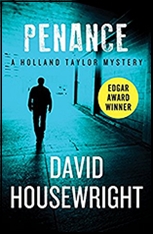Fri 27 Apr 2018
A Movie Review by Dan Stumpf: THIS SIDE OF THE LAW (1950).
Posted by Steve under Mystery movies , Reviews[11] Comments
THIS SIDE OF THE LAW Warners, 1950. Viveca Lindfors, Kent Smith, Janis Paige, Robert Douglas and John Alvin. Written by Richard Sale and Russell S. Hughes. Directed by Richard L. Bare.
Another bonus disc thrown in by a generous dealer, a film I didn’t know I had, and one I never heard of before. Turned out to be a Warners B movie made in 1948 but not released till 1950.
Top-billed Viveca Lindfors actually has little to do here except look pretty and puzzled while Kent Smith carries the bulk of the plot as a down & out drifter hired to impersonate a lookalike millionaire who has been missing for almost seven years and about to be declared legally dead.
Smith is recruited by the dead man’s lawyer (played by that perennial movie schemer Robert Douglas) for reasons of his own. And I think I’ve mentioned before that in the movies when you assume someone else’s identity, it’s always a flying leap from the frying pan. In this case, it turns out that the ancestral manse is a hotbed of domestic intrigue, including the fetching Ms. Lindfors as his bewildered and broken-hearted wife, John Alvin as a resentful weakling brother, and Janis Paige as his sister-in-law, a femme fatale in the Audrey Totter /Ann Savage mode.
One of these characters may have murdered the missing man, and it turns out the lawyer wants Smith to find out which one – or does he?
It’s all handled efficiently, but by 1948 they were making some films noirs by rote, and this is a good example. It’s told in flashback, with lots of shadows and shady characters, but they all seem a bit perfunctory, without the resonance that typifies contemporaries like The Big Clock and Cry of the City.
Richard Sale, the author of the piece, wrote the brilliant metaphysical novel Not Too Narrow, Not Too Deep, which became the movie Strange Cargo. He also wrote a whole lot of sub-standard pulp fiction and forgettable screenplays, which always puzzled me. I mean, I can almost understand someone like Harper Lee or J.D. Salinger writing a remarkable book and then leaving it alone, but how anyone can turn out a single great book smack in the middle of a career devoted to mediocrity mystifies my mind—much more than this movie did.
Similarly, director Richard Bare was a low-level fixture at Warners, doing shorts and occasional B features. When Warners went into Television in the 50s, Bare went along, lending his trademark anonymity to just about every Western and PI show Warners produced in those days. And so much for him.
Janis Paige got tired of nothing parts in Hollywood, and went to Broadway where she became a big star, then returned to the movies for an occasional character part, like the Hollywood Star making a musical version of “War and Peace” in Silk Stockings, where she gets a great number with Fred Astaire.
As for This Side of the Law, it’s painless & watchable, done with the Warners polish of the 1940s, and while I won’t go so far as to recommend it, I will admit it made for a pleasant evening.
Well anyway, you could do worse.

